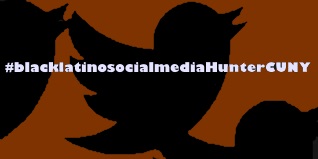The hashtags Ferguson and LaComay pertain to two different communities, being the Black and Latino community respectively. Even though they are primarily an interest to two different groups of people they share a commonality in the issue and the fashion of addressing the issue. Ferguson ,being the incident where a white police officer shoots and kills an unarmed black teenager named Mike Brown, and LaComay, a puppet commenting on that Jose Enrique died due to living a sexually promiscuous lifestyle, stirred up a revolution on social media. Both of these incidents use Social Media as a platform to collaborate and act upon. I looked at different posts under these hashtags, comparing and contrasting their activism on social media.
Looking at # LaComay I realize that most of the comments are around the time of the incidence being Decmber 2012-January 2013. This is the Time Frame of the hashtags I will look at. Many people hashtagged the Daily Show and how it brought up LaComay without exposing the recent event of the shows racist comments. This exposes the fact that media doesn’t give the most revealing story on an incident or may not even catch on to the racism that’s inherent in its culture. Media’s underestimation of the incident is one of the reasons why it is so highly present on social media. There is also a hashtag commenting on the incident, linking participants to #boicotlacomay which is a page made in effort to end the show. This is more of a motivational comment , enlightening people to take action as activists. As a mass of people joined this group a collectiveness of activism was encountered with videos of protests being posted and companies cancelling their sponsorships of the show. Four days after the incident AT&T posted a comment on Facebook announcing their withdrawal from sponsoring the show in response to the vast request of the public.
This portrays the power that social media has not only in continuing activism but giving birth to activism. ” The internet has the capacity for actually creating – not just enhancing – political activism in Latin America” (Harlow, 2011). Summer Harlow ,through her research on what role social media played in the Guatemalan community, portrays how social media has the capability of sparking activism. I also came across a hashtag containing an article titled : “Did Puerto Rico’s Social Media just Slay La Comay?” The article has a picture of the puppet with a red X mark over it. This article summarizes the events that took place throughout the incident leading to ending the show. During the week of the homophobic comment made on the show a group “Boicot La Comay” was made on both Facebook and Twitter. Within a few days the group contained 40,000 people. During that same week companies started pulling their ads from the show. And this continued until a vast amount of companies pulled their ads receiving positive comments from the public, whereas those that didn’t received persistent requests. This action persisted until January 9th when a spokesperson confirmed their show was cancelled due to Kobbo Santarrosa’s resignation from WAPA TV right before taping another show.
I have also looked at #Ferguson that is of relevance to the black community. On August 9, 2014 a white police officer killed an unarmed black teenage boy named Michael Brown in Ferguson Missouri. The incident has become highly present on social media with efforts to bring justice for Michael Brown. I have looked at hashtags that emerged at the wake of the incident being August 9th until September. The first hashtag was by a young black male named Sean S. Turner on August 9th who stated : “Police stop killing our young black men……Justice for Mike Brown”. On August 10th there were many hashtags, one of which linked to a news article and another had a picture of five people protesting in Denver. Progressively after August 10th there have been pictures posted of a group of people praying at the site and more protests. Information about campaigns about supporting both the victim and the officer have been posted. A Michael Brown Memorial Fund has raised $130,842 during eight days meanwhile Support Officer Darren Wilson campaign has raised $151,257 after only three days! Where is the justice in that? There were successive posts on protest called Hands Up which were protesting the innocent death of Mike Brown as well as many other innocent deaths of black men. There was a post of a banner called Stolen Lives which had all the victims of racial profiling that were killed. There were also a lot of posts on police brutality such as spraying gas on nonviolent protesters. The hashtags on #Ferguson created a community centered on fighting the racial injustice inherent in the system.
Both #Ferguson and #LaComay have used social media as a intersection where all came together in the fight for justice. The amount of tweets on Ferguson are massive compared to LaComay, being due to the fact that the LaComay protesters have reached their goal in boycotting the show. The protest on LaComay was silenced by the show finally resigning due to the high pressure put on the companies that advertised the show. These companies withheld their sponsorship of the show probably because they did not want to face lawsuits or a loss in customers. Social media allowed the public to have dialogues with the companies which led to such a fast response. Ferguson however is more of a uniting fight of the black community against the system that is inherently racist. The incident with Michael Brown represents so many other young male blacks that were innocently killed by the police. The posts by now have become mainly the black community against the police. Social media enlarges that what is made to be silenced by society.
Works Cited:
http://politic365.com/2013/01/09/did-puerto-ricos-social-media-just-slay-la-comay/
Harlow, Summer. “Social Media and Social Movements: Facebook and Online Guatemalan Justice Movement that Moved Offline.” August 2011.
